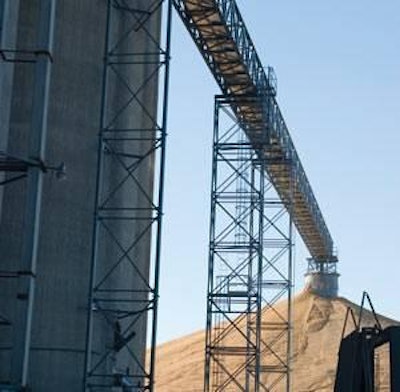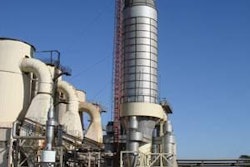
Lowered expectations for ethanol production capacity coupled with predictions of record-setting feed grain yields provide a complicated landscape for the animal feed industry in 2007. Despite predictions of record corn yields, feed prices remain strong due primarily to high wheat prices worldwide and strong soybean markets. The corn price is further propped up by expectations of fewer available acres for corn next year, partially due to normal crop rotations and partially due to competition with other crops. Lower-than-anticipated soybean production in Brazil and adverse crop weather conditions in Australia and other parts of the world are expected to keep animal feed prices strong. The feed industries of North America together produce almost one-third of the world's estimated 635 million tonnes of manufactured feed products. With annual outputs of nearly 152 million tonnes of feed, the U.S. surpasses the production of the member states of the European Union and that of all other countries. Moreover, both Mexico, with 25 million tonnes, and Canada, with just under 23 million tonnes, are also among the top 10 feed manufacturing nations in the global marketplace.
Animal food industries steady
Animal food industries saw slight increases in beef, pork, and turkey production but lower broiler meat production in the past year. That resulted in a net effect on feed consumption of about 1 percent growth, indicative of a mature, steady market. Approximately 15 percent of U.S. industrial feed now goes to animals destined for meat export.
According to USDA data, the industrial feed tonnage growth in Mexico has been strongest of all countries in North America, based mainly on expanding broiler production. Canada has maintained growth in tonnage, mainly on strong domestic meat consumption and expanded pork exports.
In the U.S., broiler feed alone accounts for nearly a quarter of all industrial feed production. Combined with egg layer and turkey feeds, the total poultry feed production represents around 38 percent of all manufactured feed. Pig feeds rank next at nearly 22 percent, followed by feeds for beef cattle at about 21 percent and dairy feeds at a little over 19 percent. Aquafeeds for catfish, trout, and shrimp are increasing in tonnage, but still amount to less than 1 percent of the U.S. total.
Table 1: Feed-price ratios, selected animals, U.S, 2007
Record corn yield predicted
According to September 2007 forecasts by the United States Department of Agriculture Economic Research Service (USDA-ERS), corn production is expected to reach a record 13.3 billion bushels, up 254 million from its prediction a month earlier due to higher-than-anticipated yields. If it comes to pass, yield would be up 2.773 billion bushels above 2006. The forecast yield of 155.8 bushels per acre would be the second highest on record, surpassing the actual 2006 yield of 149.1 bushels. Prices for feed grains remain strong, boosted by record-setting wheat and strong soybean prices.
U.S. feed grain production in 2007 is forecast at a record 357 million metric tons, up 7 million from USDA predictions a month ago, and up 77 million from 2006. Corn and sorghum production are both up from estimates last month and yields last year. USDA-ERS says forecast beginning stocks are up fractionally from predictions last month but down 23 million tons from the previous year. Feed grain supply in 2007/08 is forecast at a record 392 million tons, up 7 million tons from last month and up 55 million from 2006/07. Total feed grain use in 2007/08 is up 3 million tons this month at a record 345 million. Total use is up 40 million from 2006/07. Higher feed and residual use and exports account for the month-to-month increase in total use as corn ethanol use and sorghum (food, seed, and industrial) use are both lowered.
Table 2: Feed-price ratios, selected animals, U.S., 2006
Grain use for feed grows
When converted to a September-August marketing year, USDA-ERS says feed and residual use for the four feed grains plus wheat in 2007/08 is projected to total 168 million tons, up 3 million from expectations a month ago and up 13 million from 2006/07. Corn is estimated to account for 89 percent of the feed and residual use in 2007/08, down from 95 percent in 2006/07.
The projected index of grain-consuming animal units (GCAU) for 2007/08 was up 0.3 million units and up 0.1 million from 2006/07, according to the USDA-ERS. The change in GCAUs year-to-year was caused by increases in hogs, dairy cows, and poultry. GCAUs for cattle-on-feed were lower than in 2006/07, caused by a shifting of cattle marketing from 2007 into 2008. Because of the drought in 2006, cattle were placed earlier in 2006/07, resulting in GCAUs for cattle-on-feed being higher than in 2005/06. The grain used per GCAU in 2007/08 is expected to be 1.83 tons, up from 1.80 tons last month and 1.68 tons in 2006/07.
September data indicate the highest plant population on record for the 10 objective yield States (Illinois, Indiana, Iowa, Kansas, Minnesota, Missouri, Nebraska, Ohio, South Dakota, and Wisconsin). Record stalk and ear counts were recorded in Illinois, Indiana, Iowa, Nebraska, Ohio, South Dakota, and Wisconsin. Minnesota had a record number of plants per acre, while indicated ears per acre were the highest since 2004.
Projected corn ending stocks for 2006/07 are increased 5 million bushels from last month and are down 825 million from 2005/06. Projected exports were raised 20 million bushels this month because of a strong export pace in recent weeks.
Table 3: Selected feed and feed byproduct prices
Ethanol predictions lowered
Corn earmarked for ethanol production was lowered 25 million bushels, based on indications of declining plant capacity utilization and a slower-than-expected pace of startups. Forecast 2007/08 corn use was increased 100 million bushels from USDA predictions last month to a record 12.8 billion bushels, up 1,420 million from expected 2006/07 use. Exports were increased 100 million bushels to 2.25 billion because of reduced supplies of feed grains and feed-quality wheat outside the United States. If realized, 2007/08 corn exports would be the highest since 1989/90. Feed and residual use of corn was raised 100 million bushels this month to 5,85 million bushels because of higher yields, which are associated with increased residual use, and reduced availability of distillers' grains. Distillers' grains are expected to be lower than last month because of declining plant capacity utilization and sluggish startups, (based on Renewable Fuel Association plant numbers and ethanol production reported by The Energy Information Administration). Corn used for ethanol in 2007/08 was reduced 100 million bushels to 3.3 million bushels, up from expected use of 2.125 million bushels in 2006/07. Ending stocks of corn in 2007/08 are expected to total 1.675 million bushels, up 159 million from last month, and up 533 million from 2006/07. Supported by record wheat and strong soybean prices, the forecast corn price for 2007/08 is $2.80-$3.40 per bushel, unchanged from last month. In 2006/07, the season-average price received by farmers is expected to be $3.03 per bushel.
Table 4: Cash corn prices, number 2 yellow at selected locations, monthly
Changing structures
Increased consolidation of ownership and increased vertical integration continue to reshape the North American feed industries. However, organic and increasingly specialized and branded animal production continues to show growth, representing expanding niche markets for feed products. Feed industry leaders in North America continue to focus on feed safety as they help to organize international participation in global food and feed trade safety standards. In addition to health and food safety concerns, the feed industry is impacted by changes brought about as a result of the boom in ethanol and biodiesel production. There are also increasing concerns over environmental issues and sustainability, and a growing awareness of social-corporate responsibility involving feed manufacturing and animal agriculture.
.jpg?auto=format%2Ccompress&crop=faces&fit=crop&h=48&q=70&w=48)




.jpg?auto=format%2Ccompress&fit=crop&h=167&q=70&w=250)
.jpg?auto=format%2Ccompress&fit=crop&h=167&q=70&w=250)











